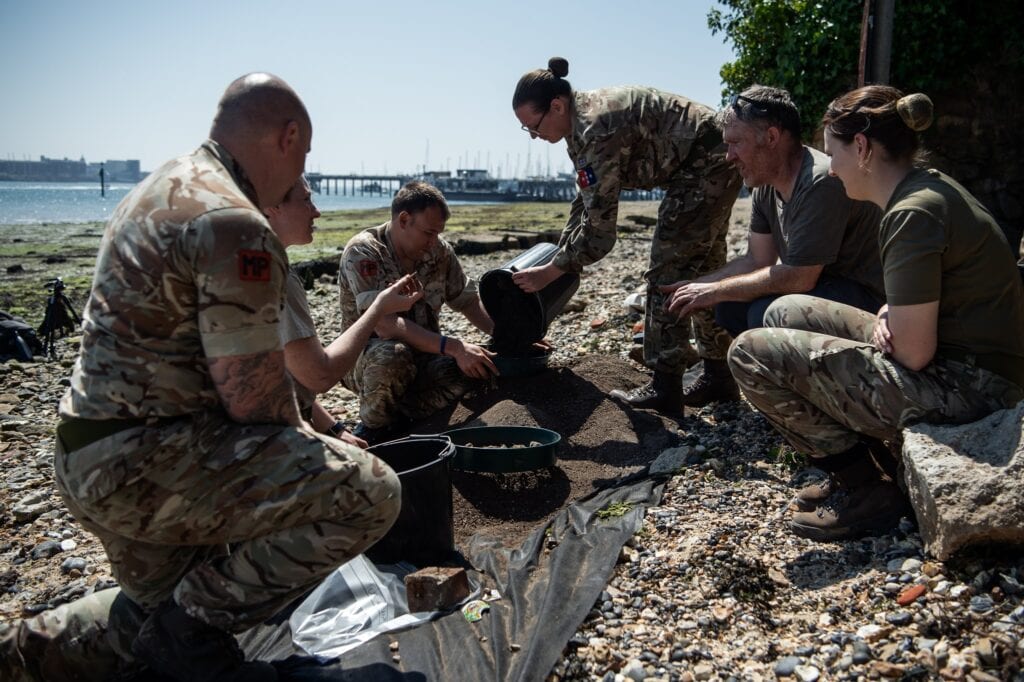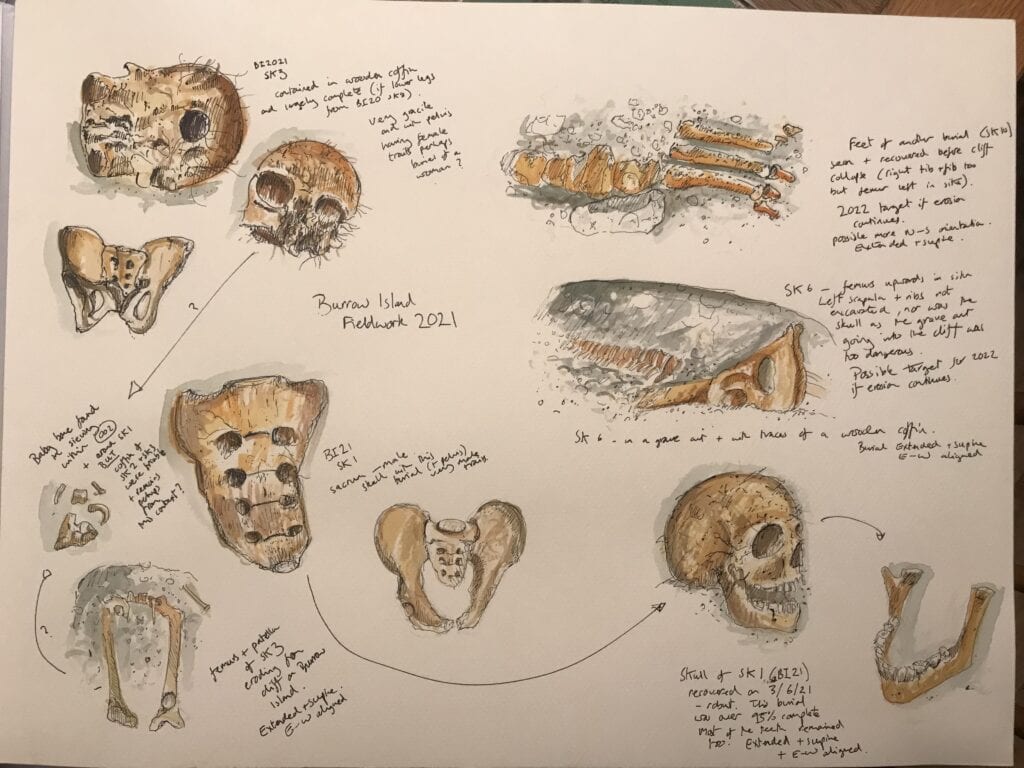
Harbour tours past this small tidal island refer to the colloquial name and claim it was so-called because of the number of rats to be found there feeding on the corpses of the prisoners that had been buried there in the Georgian era. Surely this was just another tall tale? Well, it turns out to have more than a grain of truth. After storms in 2014, the police reported the discovery of human bones on Rat Island and so as DIO’s Senior Archaeologist, I had the site send me the bones. I was half expecting them to be animal bones, but I was greeted with, amongst other elements, a very clearly human skull in an evidence bag. Further examination of the small cliff on the island showed that there were more bones eroding out.
Archaeological investigations
Since that point the archaeology team within DIO has organised several excavations on the site to recover remains affected by these storms. This work, in conjunction with Cranfield University, Breaking Ground Heritage and the Royal Military Police (RMP) has now retrieved the remains of over 35 individuals from a very small area indeed. Analysis of these bones seems to suggest them all to be adult males in their late teens to early sixties and to have suffered a variety of ailments and aches – some even seemingly with scurvy. The bodies were in elm coffins and aligned east -west in a standard Christian fashion even though this is not consecrated land. Assessment of the teeth of the bodies (and their stable isotopes) indicated that most were from southern Britain although a couple had spent their early years of life on the European mainland.
Unlike the burials of prisoners of war at nearby Portchester Castle or those of sailors at Haslar hospital, these individuals had nothing with them in their graves. This, along with a map reference to the ‘Convict burying ground’, and an 19th Century article in the Oxford Times also referring to convict inhumations, leads us to think these are the remains of prisoners who had died on the prison hulks moored around Portsmouth harbour in the late 18th and early 19th Centuries.
Latest findings

So why do we do this? It provides good and realistic training to the RMP who have body recoveries of a more recent nature as part of their job portfolio, alongside top-level forensics links. It is also an engaging piece of work for our veterans that live locally.
Finally, it is the right thing to do – our work is permitted under a Ministry of Justice license which requires us to re-bury these people on completion of the project. By collecting and recovering the remains we can tell the story of these people, avoid the ignominy of their bones simply lying around without respect, and finally ensure they are reburied properly at a location where there is no threat of erosion.
11 comments
Comment by Harry Harris posted on
Interesting. See page 130/131 of 'The Fatal Shore - a history of transportation of convicts to Australia'by Robert Hughes, 1986 as it contains details of the rat island burials from the prison hulks.
Comment by John Evans posted on
Are the femorae in the lower left part of the sketch damaged or are the epiphises missing? This is an indication of age.
Comment by dipapatel posted on
Hi John,
The lower legs (tibla and fibula) had eroded from the cliffs hence being missing. There may be an indication of age but this is something for the osteologists over the next few months.
Hope this answers your query.
Comment by John Evans posted on
Thank you. . Hope to see the osteologists comment.
Comment by BRIAN BOUCHARD posted on
During 1838 , a brewery on South Street Epsom, Surrey was run by James and William Chandler. Three of their employees were Benjamin Chapman, a cooper, aged 58, his son John Chapman, a labourer, aged 21, and Thomas Duke, aged 33, a tunner and brewer.
They were charged collectively with stealing 14 and a half gallons of beer & 9 bushels of grain, valued 17 shillings, property of their masters, brewers in Epsom. The accused were brought to be tried at Surrey Quarter Sessions, Kingston upon Thames, on 16 October 1838. All were sentenced to transportation; the Chapmans each for seven years and Thomas Duke for fourteen.
Benjamin Chapman died on 21 April 1839 incarcerated on the Leviathan hulk moored near Portsmouth.[Reg. Alverstoke, Hampshire 6/1839] He is presumed to have been interred in an unmarked grave on Burrow (alias 'Rat') Island off Portsea
Comment by Sistem Informasi posted on
Is Rat Island the current research site? Has there ever been a war on the island?
Comment by DIO Communications Team posted on
There aren't excavations underway there at the moment, but perhaps there may be more in the future. There hasn't been a war there, it's very small.
Comment by Meg McLaughlin posted on
Are there any plans to attempt to identify the bodies through DNA? My 3 x great grandfather, Thomas Arment (Armant according to the death record) died aboard the convict ship Defence in 1849. It was in Portsmouth Harbour. He was 68 according to the record. It was a harsh sentence for receiving stolen goods.
Comment by DIO Communications Team posted on
Hi Meg,
Great question! We've checked with Richard who had this to say:
"It can be quite expensive to extract DNA with no guarantee of success. Although we have some information on diets and places of origin through the isotopes, there are no plans for DNA. We have also taken radiocarbon dates from some of the individuals and most seem to be late 18th – earlier 19th C though a date of death of 1849 is not impossible. For DNA to work we would need to get a sample from the burials and then have a list of known descendants to try to match them to (ideally through the female, mitochondrial, line). Not impossible but tricky!"
He's happy to discuss further if you like - we have your email address from your comment so we can ask him to drop you a line?
DIO Communications Team
Comment by Meg McLaughlin posted on
Thank you for your reply. Yes, I would be happy to discuss the question of DNA testing further with Richard.
Comment by peanus posted on
spoooooooookyyyyyyyyyyyyy